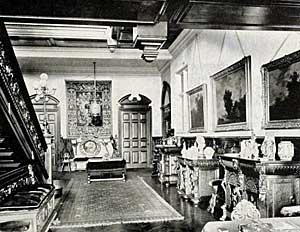The Stuarts were frequent visitors at Rufford; Thoroton says: "This place hath often entertained King James and King Charles his son, being very pleasant and commodious for hunting in the forest of Shirewood." During the Commonwealth, it was one of the places appointed for the rendezvous of persons disaffected to the Government.
The large cedar on the lawn was planted by Charles II. during one of his visits to Rufford.
Sir William Savile, the third baronet, was the leader of the Royalist forces in Yorkshire during the troublous times of the Civil War. When not engaged in fighting, he lived at Rufford; just before his death he ordered his old hall at Thornhill, near Wakefield, to be burnt down, to prevent it being used as a garrison for the forces of the Parliament. He was appointed, in 1643, Governor and Commander-in-Chief of the town and Castle of Sheffield, but died the following year. His widow, a daughter of Lord Keeper Coventry, remained on in the Castle of Sheffield, which she gallantly defended against the besiegers, although daily expecting her confinement, and being, of course, unable to obtain any medical assistance. It was only when the walls were actually battered in that her own soldiers, to save the heroic lady, gave up the keys. Lady Savile was allowed to march out with the honours of war, and to have an escort to Rufford, where she was confined the next day. Her eldest son, Sir George Savile, was destined become one of the most famous, and perhaps the most powerful man of his time. He was created Lord Savile, then Viscount, and afterwards Marquis of Halifax.

The Picture Gallery.
This great statesman adored his Nottinghamshire home, and in spite of the high positions he occupied and the honours that were conferred upon him, he was never so happy as when he could live quietly down there among his books and pictures. In writing from Windsor Castle at the end of July 1679, where he was detained by the cares of office, he laments that the summer is passing without his being able to see his poor old Rufford, which he prefers to Windsor in all its glory, and yearns for with the longing of an absent lover.

The Grand Staircase.
To the "Trimmer," however, it is due that but a portion now remains of the original Abbey. In a letter dated from Rufford, February 7th, 1680, to his brother Henry Savile—then Envoy Extraordinary' to Louis XIV., he begins :—
"I am once more got to my old tenement, which I had not seen since I had given orders to renew and repair it. It looketh now somewhat better than when you was last here; and besides the charms of your native soil, it hath something more to recommend itself to your kindness, than when it was so mixt with the old ruins of the abbey that it looked like a medley of superstition and sacriledge, and though I have still left some decayed front of old building, yet there are none of the rags of Rome remaining. It is now all heresye, which in my mind looketh pretty well, and I have at least so much reverence for it now as I had when it was encumbered with those sanctified ruins."
Lord Halifax married firstly, Dorothy Spencer, daughter of the Earl of Sunder-land and of the famous "Sacharissa," who was constantly at Rufford, and who was an ardent admirer of the character and talents of her son-in-law. Indeed, after the death of her second husband, Sir Robert Smythe, Lady Sunderland appears to have made it her home from 1663 to the autumn of 1667.
